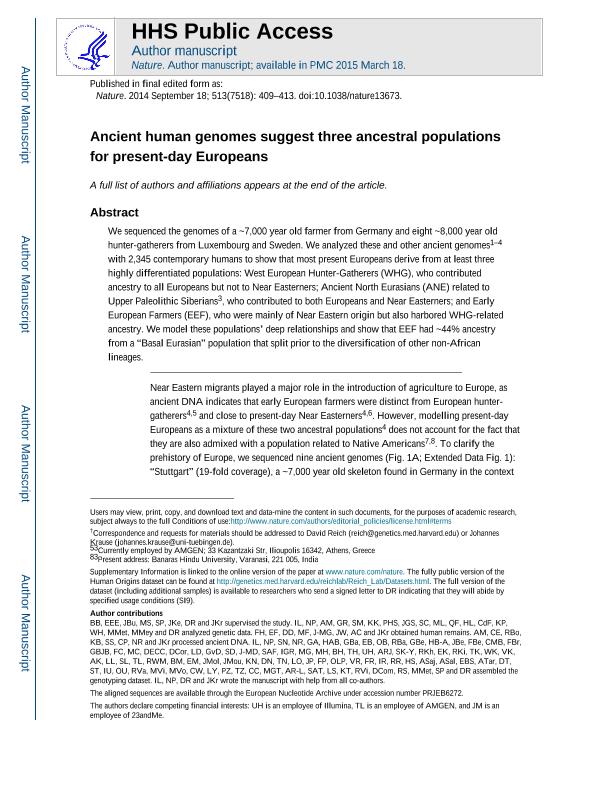Artículo
Ancient human genomes suggest three ancestral populations for present-day Europeans
Lazaridis, Iosif; Patterson, Nick; Mittnik, Alissa; Renaud, Gabriel; Mallick, Swapan; Bailliet, Graciela ; Bravi, Claudio Marcelo
; Bravi, Claudio Marcelo ; Corach, Daniel
; Corach, Daniel ; Thomas, Mark G.; Ruiz Linares, Andres; Tishkoff, Sarah A.; Singh, Lalji; Thangaraj, Kumarasamy; Villems, Richard; Comas, David; Rem Sukernik; Metspalu, Mait; Meyer, Matthias; Eichler, Evan E.; Burger, Joachim; Slatkin, Montgomery; Pääbo, Svante; Kelso, Janet; Reich, David; Krause, Johannes
; Thomas, Mark G.; Ruiz Linares, Andres; Tishkoff, Sarah A.; Singh, Lalji; Thangaraj, Kumarasamy; Villems, Richard; Comas, David; Rem Sukernik; Metspalu, Mait; Meyer, Matthias; Eichler, Evan E.; Burger, Joachim; Slatkin, Montgomery; Pääbo, Svante; Kelso, Janet; Reich, David; Krause, Johannes
 ; Bravi, Claudio Marcelo
; Bravi, Claudio Marcelo ; Corach, Daniel
; Corach, Daniel ; Thomas, Mark G.; Ruiz Linares, Andres; Tishkoff, Sarah A.; Singh, Lalji; Thangaraj, Kumarasamy; Villems, Richard; Comas, David; Rem Sukernik; Metspalu, Mait; Meyer, Matthias; Eichler, Evan E.; Burger, Joachim; Slatkin, Montgomery; Pääbo, Svante; Kelso, Janet; Reich, David; Krause, Johannes
; Thomas, Mark G.; Ruiz Linares, Andres; Tishkoff, Sarah A.; Singh, Lalji; Thangaraj, Kumarasamy; Villems, Richard; Comas, David; Rem Sukernik; Metspalu, Mait; Meyer, Matthias; Eichler, Evan E.; Burger, Joachim; Slatkin, Montgomery; Pääbo, Svante; Kelso, Janet; Reich, David; Krause, Johannes
Fecha de publicación:
09/2014
Editorial:
Nature Publishing Group
Revista:
Nature
ISSN:
0028-0836
e-ISSN:
1476-4687
Idioma:
Inglés
Tipo de recurso:
Artículo publicado
Clasificación temática:
Resumen
We sequenced the genomes of a ∼7,000-year-old farmer from Germany and eight ∼8,000-year-old hunter-gatherers from Luxembourg and Sweden. We analysed these and other ancient genomes1,2,3,4 with 2,345 contemporary humans to show that most present-day Europeans derive from at least three highly differentiated populations: west European hunter-gatherers, who contributed ancestry to all Europeans but not to Near Easterners; ancient north Eurasians related to Upper Palaeolithic Siberians3, who contributed to both Europeans and Near Easterners; and early European farmers, who were mainly of Near Eastern origin but also harboured west European hunter-gatherer related ancestry. We model these populations’ deep relationships and show that early European farmers had ∼44% ancestry from a ‘basal Eurasian’ population that split before the diversification of other non-African lineages.
Palabras clave:
Ancient Dna
,
Genomics
,
Human Origins
,
Europe
Archivos asociados
Licencia
Identificadores
Colecciones
Articulos(IMBICE)
Articulos de INST.MULTIDISCIPL.DE BIOLOGIA CELULAR (I)
Articulos de INST.MULTIDISCIPL.DE BIOLOGIA CELULAR (I)
Articulos(OCA HOUSSAY)
Articulos de OFICINA DE COORDINACION ADMINISTRATIVA HOUSSAY
Articulos de OFICINA DE COORDINACION ADMINISTRATIVA HOUSSAY
Citación
Lazaridis, Iosif; Patterson, Nick; Mittnik, Alissa; Renaud, Gabriel; Mallick, Swapan; et al.; Ancient human genomes suggest three ancestral populations for present-day Europeans; Nature Publishing Group; Nature; 513; 9-2014; 409-413
Compartir
Altmétricas



